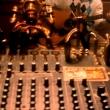In my years of playing guitar, both professionally and for pure
enjoyment, one phrase has been my greatest inspiration. That phrase is, "You
can't do that". I love a challenge more than anything else when it comes to
playing. If someone says that there is no way that a guitarist can do this
or that, my first response is to go home, pick up the guitar and prove them
wrong. I play mainly acoustic guitar. The way I play stems from the "...you can't do that" theory.
Of all the instruments out there, the acoustic guitar has some of the
greatest untapped (no pun intended) potential. Most folks view acoustic
guitar as being played one of two ways, either strummed with a pick or
plucked with the fingers. Fine techniques, but sometimes a composition
requires something a little more over-the-top.
Before we go into techniques, let's look at something that has
nothing to do with playing the guitar at all to get an idea of the concept.
In basketball, there are many basic skills to the game. Jump shots, free throws, ball movement and basic defense. Most basketball players have a special talent for one or the other of these essentials. The individual works on that talent and becomes very good in that one area. For many years this was the standard for most players in the game. Every once in a while though, a player comes around who changes that philosophy and develops the skills that prove all the former rules of what can and can not be done to be wrong.
Michael Jordan is the best example of this in professional basketball. Michael is a great shooter, ball handler, defensive player and has even created moves and plays that have been thought impossible before. Think about it, before him who would have thought that someone could actually jump from the free throw line, pump fake and dunk a basketball?
Michael Jordan does not do what he does to be flashy or show up his
teammates. He does what he does because it facilitates his game and what he can contribute to both the team and the game itself. In guitar playing, the concept of going beyond what has been done before and actually contributing something new and fresh to music is just as valid as it is in sports or any other field. The first thing one has to do as a musician if they wish to truly contribute something new is get past the idea that something can't be done. Here is an idea to help you on your way to new territories with your music.
We will be using my instrument of choice for this example; the
acoustic guitar. Here we go! First, tune your strings a little differently.
From low to high the tuning will be D,A,D,F#,B,E. I know, I know, it's an
odd-ball tuning, but bear with me here. Instead of using a traditional
right-hand strumming or picking method, let's focus our attention on 12th
fret harmonics. I use a striking/slapping method with my index, middle and
ring fingers on the right hand to achieve this. Use these three fingers to
hit right at the top fret wire of the 12th fret. The sound should be rather
percussive. Set any rhythm for yourself that you feel comfortable with. Once
you have developed a solid rhythm and can get all six strings to ring the
harmonics clearly, put your left middle finger on the A string, second fret.
Hammer and pull-off the fret several times to get a good coordination
between your left and right hands. Now, move your finger up to the fourth
and fifth frets and then back down to the second fret. Feel free to
experiment with different note combinations here, I'm just giving you the
basic technique.
The overall sound should come across as a moving melody line (what
your left hand is doing), a percussive rhythm element and a underlying
chordal structure to hold it all together (what your right hand is doing).
If you record it and play it back it should sound like more than one
instrument even though you are doing this all at once, by yourself. Believe
it or not, I actually get studio calls for this type of stuff. It is because
I never believed that it could not be done that I was able to develop this
technique and make it a useful part of my repertoire.
Like Michael Jordan on the court, you can develop a style with your
guitar that is unique and goes beyond what everyone else thought possible.
Try new ideas and don't be afraid to deviate from the norm every once in a
while. Above all, take the initiative when someone says, "You can't do
that!" Keep practicing, because I'll bet you can do that!
Chris Brown is a studio guitarist/solo artist residing in Murfreesboro, Tennessee. Chris has been playing for twelve years, both solo and in several bands. He has played in several studio sessions in Nashville and the Nashville area and is called upon regularly to play with back-up bands in events and productions.
He is most noted for his adventurous acoustic guitar work, but also plays rock and other styles proficiently.
